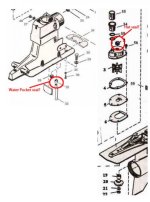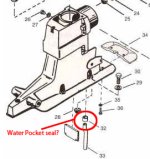One manifold always runs warmer than the other but not hot to the touch. Rod's tet tells you how much water the impeller is pumping.
Water flow to each manifold is controlled by the T'stat hsg. A second water flow test determines the volume of water going to the manifolds using clear plastic hoses while the outdrive is immersed in water and not connected to a garden hose with muffs. This method also tests the water pressure that the impeller puts out and the distribution of the water flow by the thermostat hsg.
If there are no bubbles in the water flow to the manifolds and the water flow is weak to one manifold then the T'stat hsg. is the likely culprit if the impeller output test (Rod's) is good. If there are air bubbles in the clear hoses, the air bubbles will not transfer manifold heat. The source of the bubbles is most likely the outdrive. There is a water pocket seal at the base of the upper half of the OD that the copper water tube is inserted. If the seal leaks exhaust/air can enter the water stream. The impeller housing can also allow air into the water stream especially if the plastic hsg. upper/lower halves are distorted from a prior overheat--they have to be replaced. Perfect seal on the base gaskets can stop air intrusion. JMO
...have thoroughly inspected the thermostat housing, both the water lines running to the bottom side of both exhaust manifolds,
Water flow to each manifold is controlled by the T'stat hsg. A second water flow test determines the volume of water going to the manifolds using clear plastic hoses while the outdrive is immersed in water and not connected to a garden hose with muffs. This method also tests the water pressure that the impeller puts out and the distribution of the water flow by the thermostat hsg.
If there are no bubbles in the water flow to the manifolds and the water flow is weak to one manifold then the T'stat hsg. is the likely culprit if the impeller output test (Rod's) is good. If there are air bubbles in the clear hoses, the air bubbles will not transfer manifold heat. The source of the bubbles is most likely the outdrive. There is a water pocket seal at the base of the upper half of the OD that the copper water tube is inserted. If the seal leaks exhaust/air can enter the water stream. The impeller housing can also allow air into the water stream especially if the plastic hsg. upper/lower halves are distorted from a prior overheat--they have to be replaced. Perfect seal on the base gaskets can stop air intrusion. JMO



